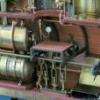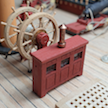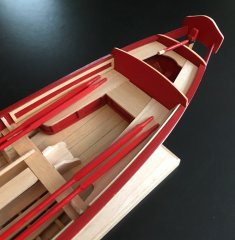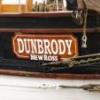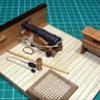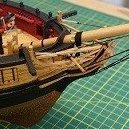Supplies of the Ship Modeler's Handbook are running out. Get your copy NOW before they are gone! Click on photo to order.
×
-
Posts
863 -
Joined
-
Last visited
Reputation Activity
-
 Heronguy got a reaction from Canute in Why use a CNC Mill
Heronguy got a reaction from Canute in Why use a CNC Mill
Thanks Pat,
By the way, my name, Doug, is in my signature, like yours
I agree that cost/benefit analysis is valid. I don’t assign cost to the learning and the setup phases - is a personal choice but not fair to assume for others.
In in terms of benefits I don’t know how I’d have milled the bracket without CNC. I suppose if it wasn’t an option I’d have settled for the soldered bracket and perhaps even practiced more to do a better job. I was pretty pumped by my milled piece though - that’s worth something for me!
-
 Heronguy got a reaction from Canute in Why use a CNC Mill
Heronguy got a reaction from Canute in Why use a CNC Mill
I'd love to hear how others on this site are using their CNC mills and lathes. I have a lathe on order and although I debated CNC vs DRO for the lathe I eventually decided on the CNC version since the computer interface provide the equivalent of DRO information another seem to me to be opportunities if controlling X and Z axes concurrently on the lathe (I'm thinking balusters for railings for example - I might want to produce many identical ones).
-
 Heronguy got a reaction from Canute in Why use a CNC Mill
Heronguy got a reaction from Canute in Why use a CNC Mill
Pros and cons of CNC Mill
The advantages obtained by CNC capability on the mill include:
ability to move the cutter in any of the 4 axes simultaneously (e.g. milling an arc)
precise control over movements
ability to reproduce multiple identical parts
the joy of watching the machine do the work
The disadvantages include:
having to specify milling intentions in a very primitive programming language (g-code)
learning curve of the CNC programming language (g-code)
cost of the system
Things I still have to explore:
CAM software for designing parts (I’ve played with FreeCAD and ben frustrated, will try out Fusion360)
Path generating software ( to take CAM model and generate the g-code to machine the part.
Things to be aware of:
There is no magic in the systems at present You still have to know how the part can be milled. You have to specify the order things happen, the tools to use, and you have to know the capabilities and limitation of your particular mill and tools.
-
 Heronguy got a reaction from Canute in Why use a CNC Mill
Heronguy got a reaction from Canute in Why use a CNC Mill
Last summer I was fortunate enough to get good deal on a Sherline 2000 CNC mill. As a former software developer I was intrigued with the idea of computer control but as a novice ship builder and novice wood/metal worker I thought It would be most likely that I would just use it in manual mode with the hand wheels while I learned some skills.
One of my 1st "projects" involved making a weaving accessory for my spouse. That involved a simple pattern of drill holes in a board. The CNC program was pretty trivial but it was cool to stand back and watch the machine do the work (my management credo: "I love work - I can sit and watch it for hours").
But what about ship modelling use. The 2nd project was working on a "riveting Jig" based on the Syren jig defined by Chuck P. More drilling but to tighter tolerances.
This took a lot longer due to learning about milling machine backlash adjustments as I tried to debug a systematic error in the positioning of the holes in the 2nd and 3rd rows.
More recently I wanted to square a section of the main mast on my Essex cross section. This was exciting as it was an opportunity to to use the rotary table that came with the mill. This was another little job that I wanted to do precisely and, since I can lose count on the hand wheels quicker than I can turn them, I used the computer interface in manual mode (so the computer drives the CNC steppers in response to individual move instructions - basically gives you DRO capability - no need to count hand wheel turns). I practiced the moves on a spare bit of doweling to be sure before I put the already prepared mast near the cutter.
It was going well until I jogged left instead of right! One ruined mast.
To be fair I could have made the same mistake with the hand wheels but the damage would have been minimal. Time, I decided, to write the CNC program to square my mast.
I realize that all of this stuff could be done with the mill in manual mode, but as I said, I love "work watching".
Last week I finally came up with a need for the CNC mill that I couldn't have done otherwise.
The brackets to hold the stunsail booms to the yards (if I've got the correct words ) for the Essex cross-section were horrible(plywood) and making them
out of brass sheet silver soldered didn't turn out too well, so I decided to try milling them.
I really like the result. The milling took over 40 minutes the 1st time (with a 1mm end mill I used a really low feed rate). The 2nd 3rd and 4th ones one took 12 minutes and I ramped up fedd rate and depth of each pass. There were 2 small manual steps after milling the basis shape. I drilled the holes for the spars rather than having the end mill do that part, and I flipped the piece over to mill the substrate off freeing the bracket from the stock.
-
 Heronguy got a reaction from popeye the sailor in Prince de Neufchatel by Heronguy - Model Shipways - Scale 1:64
Heronguy got a reaction from popeye the sailor in Prince de Neufchatel by Heronguy - Model Shipways - Scale 1:64
Thank you Tim. I've followed you love/hate relationship with your build (I know it is a bit strong to describe it that way). I must assume that your standards are much higher than mine - I really like what you're accomplishing with it.
-
 Heronguy got a reaction from GrandpaPhil in Prince de Neufchatel by Heronguy - Model Shipways - Scale 1:64
Heronguy got a reaction from GrandpaPhil in Prince de Neufchatel by Heronguy - Model Shipways - Scale 1:64
I put the ship's boats aside for a while and went on to the deck furnishings.
They look so plain (especially the forward companionway) that I am tempted to try to do better. @Tim I. did such a great job on his interpretation of the cabin and companionway in Philip Reed's book (Period Ship Modelmaking - An Illustrated Masterclass) that I will try to do similarly.
Just started on that process
-
 Heronguy got a reaction from John Allen in Barque Stefano by Heronguy - MarisStella - 1:63
Heronguy got a reaction from John Allen in Barque Stefano by Heronguy - MarisStella - 1:63
1st planking was completed a while ago and 2nd planking is well underway.
The challenge with the 2nd planking was clamping around the stern where the filler block didn't allow the clamp jaws to rest. Since the filler block will be removed in a future step it seemed far to cut a channel now to provide clamping surface.
When that wouldn't work I tried elastics to provide some clamping force.
But soon the clamps wouldn't work. On this site I recently read (and of course forgot to note from whom I got the idea) that using a planking iron to heat the plank accelerated the setting of the wood glue. This turned out to be a brilliant idea. I've been using it to attach each of the 100mm planks. It takes about 10-15 seconds for the adhesive to set. It works especially well on the curvy bits. I think the moisture in the PVA glue, when heated, helps the wood to adopt the shape of the surface it is pressed on. I have not used any CA adhesive.
Thank you ????? I wish I could find the post I read to give proper credit. I am grateful! Planking has just reached past the waterline. All the planks so far are full width. I'll shape the ones from here to the keel as required with the likelihood of some stealers and/or drop planks. Below the waterline the hull will be coppered (a 3rd layer!)
-
 Heronguy got a reaction from mtaylor in Why use a CNC Mill
Heronguy got a reaction from mtaylor in Why use a CNC Mill
Pros and cons of CNC Mill
The advantages obtained by CNC capability on the mill include:
ability to move the cutter in any of the 4 axes simultaneously (e.g. milling an arc)
precise control over movements
ability to reproduce multiple identical parts
the joy of watching the machine do the work
The disadvantages include:
having to specify milling intentions in a very primitive programming language (g-code)
learning curve of the CNC programming language (g-code)
cost of the system
Things I still have to explore:
CAM software for designing parts (I’ve played with FreeCAD and ben frustrated, will try out Fusion360)
Path generating software ( to take CAM model and generate the g-code to machine the part.
Things to be aware of:
There is no magic in the systems at present You still have to know how the part can be milled. You have to specify the order things happen, the tools to use, and you have to know the capabilities and limitation of your particular mill and tools.
-
 Heronguy got a reaction from popeye the sailor in Prince de Neufchatel by Heronguy - Model Shipways - Scale 1:64
Heronguy got a reaction from popeye the sailor in Prince de Neufchatel by Heronguy - Model Shipways - Scale 1:64
I put the ship's boats aside for a while and went on to the deck furnishings.
They look so plain (especially the forward companionway) that I am tempted to try to do better. @Tim I. did such a great job on his interpretation of the cabin and companionway in Philip Reed's book (Period Ship Modelmaking - An Illustrated Masterclass) that I will try to do similarly.
Just started on that process
-
 Heronguy got a reaction from GrandpaPhil in US Brig Syren by Heronguy - Model Shipways - Scale 1:64
Heronguy got a reaction from GrandpaPhil in US Brig Syren by Heronguy - Model Shipways - Scale 1:64
Since the last post I've planked and painted the inner bulwarks and planked the deck.
-
 Heronguy got a reaction from jwvolz in Prince de Neufchatel by Heronguy - Model Shipways - Scale 1:64
Heronguy got a reaction from jwvolz in Prince de Neufchatel by Heronguy - Model Shipways - Scale 1:64
I put the ship's boats aside for a while and went on to the deck furnishings.
They look so plain (especially the forward companionway) that I am tempted to try to do better. @Tim I. did such a great job on his interpretation of the cabin and companionway in Philip Reed's book (Period Ship Modelmaking - An Illustrated Masterclass) that I will try to do similarly.
Just started on that process
-
 Heronguy got a reaction from popeye the sailor in Barque Stefano by Heronguy - MarisStella - 1:63
Heronguy got a reaction from popeye the sailor in Barque Stefano by Heronguy - MarisStella - 1:63
1st planking was completed a while ago and 2nd planking is well underway.
The challenge with the 2nd planking was clamping around the stern where the filler block didn't allow the clamp jaws to rest. Since the filler block will be removed in a future step it seemed far to cut a channel now to provide clamping surface.
When that wouldn't work I tried elastics to provide some clamping force.
But soon the clamps wouldn't work. On this site I recently read (and of course forgot to note from whom I got the idea) that using a planking iron to heat the plank accelerated the setting of the wood glue. This turned out to be a brilliant idea. I've been using it to attach each of the 100mm planks. It takes about 10-15 seconds for the adhesive to set. It works especially well on the curvy bits. I think the moisture in the PVA glue, when heated, helps the wood to adopt the shape of the surface it is pressed on. I have not used any CA adhesive.
Thank you ????? I wish I could find the post I read to give proper credit. I am grateful! Planking has just reached past the waterline. All the planks so far are full width. I'll shape the ones from here to the keel as required with the likelihood of some stealers and/or drop planks. Below the waterline the hull will be coppered (a 3rd layer!)
-
 Heronguy got a reaction from Gahm in US Brig Syren by Heronguy - Model Shipways - Scale 1:64
Heronguy got a reaction from Gahm in US Brig Syren by Heronguy - Model Shipways - Scale 1:64
Since the last post I've planked and painted the inner bulwarks and planked the deck.
-
 Heronguy got a reaction from svein erik in US Brig Syren by Heronguy - Model Shipways - Scale 1:64
Heronguy got a reaction from svein erik in US Brig Syren by Heronguy - Model Shipways - Scale 1:64
Since the last post I've planked and painted the inner bulwarks and planked the deck.
-
 Heronguy got a reaction from robdurant in Prince de Neufchatel by Heronguy - Model Shipways - Scale 1:64
Heronguy got a reaction from robdurant in Prince de Neufchatel by Heronguy - Model Shipways - Scale 1:64
I put the ship's boats aside for a while and went on to the deck furnishings.
They look so plain (especially the forward companionway) that I am tempted to try to do better. @Tim I. did such a great job on his interpretation of the cabin and companionway in Philip Reed's book (Period Ship Modelmaking - An Illustrated Masterclass) that I will try to do similarly.
Just started on that process
-
 Heronguy got a reaction from mtaylor in Why use a CNC Mill
Heronguy got a reaction from mtaylor in Why use a CNC Mill
Last summer I was fortunate enough to get good deal on a Sherline 2000 CNC mill. As a former software developer I was intrigued with the idea of computer control but as a novice ship builder and novice wood/metal worker I thought It would be most likely that I would just use it in manual mode with the hand wheels while I learned some skills.
One of my 1st "projects" involved making a weaving accessory for my spouse. That involved a simple pattern of drill holes in a board. The CNC program was pretty trivial but it was cool to stand back and watch the machine do the work (my management credo: "I love work - I can sit and watch it for hours").
But what about ship modelling use. The 2nd project was working on a "riveting Jig" based on the Syren jig defined by Chuck P. More drilling but to tighter tolerances.
This took a lot longer due to learning about milling machine backlash adjustments as I tried to debug a systematic error in the positioning of the holes in the 2nd and 3rd rows.
More recently I wanted to square a section of the main mast on my Essex cross section. This was exciting as it was an opportunity to to use the rotary table that came with the mill. This was another little job that I wanted to do precisely and, since I can lose count on the hand wheels quicker than I can turn them, I used the computer interface in manual mode (so the computer drives the CNC steppers in response to individual move instructions - basically gives you DRO capability - no need to count hand wheel turns). I practiced the moves on a spare bit of doweling to be sure before I put the already prepared mast near the cutter.
It was going well until I jogged left instead of right! One ruined mast.
To be fair I could have made the same mistake with the hand wheels but the damage would have been minimal. Time, I decided, to write the CNC program to square my mast.
I realize that all of this stuff could be done with the mill in manual mode, but as I said, I love "work watching".
Last week I finally came up with a need for the CNC mill that I couldn't have done otherwise.
The brackets to hold the stunsail booms to the yards (if I've got the correct words ) for the Essex cross-section were horrible(plywood) and making them
out of brass sheet silver soldered didn't turn out too well, so I decided to try milling them.
I really like the result. The milling took over 40 minutes the 1st time (with a 1mm end mill I used a really low feed rate). The 2nd 3rd and 4th ones one took 12 minutes and I ramped up fedd rate and depth of each pass. There were 2 small manual steps after milling the basis shape. I drilled the holes for the spars rather than having the end mill do that part, and I flipped the piece over to mill the substrate off freeing the bracket from the stock.
-
 Heronguy got a reaction from Tigersteve in US Brig Syren by Heronguy - Model Shipways - Scale 1:64
Heronguy got a reaction from Tigersteve in US Brig Syren by Heronguy - Model Shipways - Scale 1:64
Since the last post I've planked and painted the inner bulwarks and planked the deck.
-
 Heronguy got a reaction from Tom E in Prince de Neufchatel by Heronguy - Model Shipways - Scale 1:64
Heronguy got a reaction from Tom E in Prince de Neufchatel by Heronguy - Model Shipways - Scale 1:64
Pushing on with the little boats. I won't use either for the PdN build but I'm taking each a bit further.
I'm now convinced that I can build a Model Expo ship's boat (and I have a kit on order to prove that conjecture). I think I've made enough mistakes on the one's 2 I've built so far that I'm running out of goofs to try out .
Here's where the "prototype" is at the moment. This one is the 2nd-planked version.
The original Model Expo boat that I was building last year has also come along. I decided to use some boxwood strips that came in a package of miscellaneous pieces from Crown Timber yard for the planking. it was nice to work with boxwood - it was my 1st experience with it. I won't bother taking this little build any further.
The Dusek's ship boat side project came together pretty well - the planking was a bit more challenging that I hoped so I'll end up filling and then painting the outer hull. I still recommend the kit if you want a little break from other builds. There is still a few details to finish on this build.
-
 Heronguy got a reaction from Tigersteve in Prince de Neufchatel by Heronguy - Model Shipways - Scale 1:64
Heronguy got a reaction from Tigersteve in Prince de Neufchatel by Heronguy - Model Shipways - Scale 1:64
I put the ship's boats aside for a while and went on to the deck furnishings.
They look so plain (especially the forward companionway) that I am tempted to try to do better. @Tim I. did such a great job on his interpretation of the cabin and companionway in Philip Reed's book (Period Ship Modelmaking - An Illustrated Masterclass) that I will try to do similarly.
Just started on that process
-
 Heronguy reacted to BANYAN in Why use a CNC Mill
Heronguy reacted to BANYAN in Why use a CNC Mill
An interesting analysis Heronguy (name? - sorry I hate using avatar names but I acknowledge privacy is a personal choice also). I went through the DRO vs CNC analysis when I purchased my Sherline also and the DRO won out mainly due to the cons you point out. I have found that except for a very few tasks most can be achieved with a DRO with some care and patience. The two main drivers for my choice were the amount of time I expended on learning yet another skill and, I would still end up with a number of failures etc due to not programming correctly. I therefore went manual, with the assistance of the DRO, to do the jobs I do.
When it came down to it it was simple maths and economics:
- how often in a build do I use the mill?
- how long would it take me to set up the job (for both)?
- does the cost differential warrant this?
That said, if you have a CNC and mastered G-code; and even better if you can draw the 3D object and transfer/translate to G-code then it is certainly quicker and more efficient to use CNC. Another benefit I suppose is that you could achieve outputs with CNC with far less accessories such as tilting tables, compound cutters (taper accessory) etc.
cheers
Pat
-
 Heronguy got a reaction from Mahuna in Why use a CNC Mill
Heronguy got a reaction from Mahuna in Why use a CNC Mill
Pros and cons of CNC Mill
The advantages obtained by CNC capability on the mill include:
ability to move the cutter in any of the 4 axes simultaneously (e.g. milling an arc)
precise control over movements
ability to reproduce multiple identical parts
the joy of watching the machine do the work
The disadvantages include:
having to specify milling intentions in a very primitive programming language (g-code)
learning curve of the CNC programming language (g-code)
cost of the system
Things I still have to explore:
CAM software for designing parts (I’ve played with FreeCAD and ben frustrated, will try out Fusion360)
Path generating software ( to take CAM model and generate the g-code to machine the part.
Things to be aware of:
There is no magic in the systems at present You still have to know how the part can be milled. You have to specify the order things happen, the tools to use, and you have to know the capabilities and limitation of your particular mill and tools.
-
 Heronguy got a reaction from Jim Rogers in Why use a CNC Mill
Heronguy got a reaction from Jim Rogers in Why use a CNC Mill
Last summer I was fortunate enough to get good deal on a Sherline 2000 CNC mill. As a former software developer I was intrigued with the idea of computer control but as a novice ship builder and novice wood/metal worker I thought It would be most likely that I would just use it in manual mode with the hand wheels while I learned some skills.
One of my 1st "projects" involved making a weaving accessory for my spouse. That involved a simple pattern of drill holes in a board. The CNC program was pretty trivial but it was cool to stand back and watch the machine do the work (my management credo: "I love work - I can sit and watch it for hours").
But what about ship modelling use. The 2nd project was working on a "riveting Jig" based on the Syren jig defined by Chuck P. More drilling but to tighter tolerances.
This took a lot longer due to learning about milling machine backlash adjustments as I tried to debug a systematic error in the positioning of the holes in the 2nd and 3rd rows.
More recently I wanted to square a section of the main mast on my Essex cross section. This was exciting as it was an opportunity to to use the rotary table that came with the mill. This was another little job that I wanted to do precisely and, since I can lose count on the hand wheels quicker than I can turn them, I used the computer interface in manual mode (so the computer drives the CNC steppers in response to individual move instructions - basically gives you DRO capability - no need to count hand wheel turns). I practiced the moves on a spare bit of doweling to be sure before I put the already prepared mast near the cutter.
It was going well until I jogged left instead of right! One ruined mast.
To be fair I could have made the same mistake with the hand wheels but the damage would have been minimal. Time, I decided, to write the CNC program to square my mast.
I realize that all of this stuff could be done with the mill in manual mode, but as I said, I love "work watching".
Last week I finally came up with a need for the CNC mill that I couldn't have done otherwise.
The brackets to hold the stunsail booms to the yards (if I've got the correct words ) for the Essex cross-section were horrible(plywood) and making them
out of brass sheet silver soldered didn't turn out too well, so I decided to try milling them.
I really like the result. The milling took over 40 minutes the 1st time (with a 1mm end mill I used a really low feed rate). The 2nd 3rd and 4th ones one took 12 minutes and I ramped up fedd rate and depth of each pass. There were 2 small manual steps after milling the basis shape. I drilled the holes for the spars rather than having the end mill do that part, and I flipped the piece over to mill the substrate off freeing the bracket from the stock.
-
 Heronguy got a reaction from BANYAN in Why use a CNC Mill
Heronguy got a reaction from BANYAN in Why use a CNC Mill
Pros and cons of CNC Mill
The advantages obtained by CNC capability on the mill include:
ability to move the cutter in any of the 4 axes simultaneously (e.g. milling an arc)
precise control over movements
ability to reproduce multiple identical parts
the joy of watching the machine do the work
The disadvantages include:
having to specify milling intentions in a very primitive programming language (g-code)
learning curve of the CNC programming language (g-code)
cost of the system
Things I still have to explore:
CAM software for designing parts (I’ve played with FreeCAD and ben frustrated, will try out Fusion360)
Path generating software ( to take CAM model and generate the g-code to machine the part.
Things to be aware of:
There is no magic in the systems at present You still have to know how the part can be milled. You have to specify the order things happen, the tools to use, and you have to know the capabilities and limitation of your particular mill and tools.
-
 Heronguy got a reaction from BANYAN in Why use a CNC Mill
Heronguy got a reaction from BANYAN in Why use a CNC Mill
Last summer I was fortunate enough to get good deal on a Sherline 2000 CNC mill. As a former software developer I was intrigued with the idea of computer control but as a novice ship builder and novice wood/metal worker I thought It would be most likely that I would just use it in manual mode with the hand wheels while I learned some skills.
One of my 1st "projects" involved making a weaving accessory for my spouse. That involved a simple pattern of drill holes in a board. The CNC program was pretty trivial but it was cool to stand back and watch the machine do the work (my management credo: "I love work - I can sit and watch it for hours").
But what about ship modelling use. The 2nd project was working on a "riveting Jig" based on the Syren jig defined by Chuck P. More drilling but to tighter tolerances.
This took a lot longer due to learning about milling machine backlash adjustments as I tried to debug a systematic error in the positioning of the holes in the 2nd and 3rd rows.
More recently I wanted to square a section of the main mast on my Essex cross section. This was exciting as it was an opportunity to to use the rotary table that came with the mill. This was another little job that I wanted to do precisely and, since I can lose count on the hand wheels quicker than I can turn them, I used the computer interface in manual mode (so the computer drives the CNC steppers in response to individual move instructions - basically gives you DRO capability - no need to count hand wheel turns). I practiced the moves on a spare bit of doweling to be sure before I put the already prepared mast near the cutter.
It was going well until I jogged left instead of right! One ruined mast.
To be fair I could have made the same mistake with the hand wheels but the damage would have been minimal. Time, I decided, to write the CNC program to square my mast.
I realize that all of this stuff could be done with the mill in manual mode, but as I said, I love "work watching".
Last week I finally came up with a need for the CNC mill that I couldn't have done otherwise.
The brackets to hold the stunsail booms to the yards (if I've got the correct words ) for the Essex cross-section were horrible(plywood) and making them
out of brass sheet silver soldered didn't turn out too well, so I decided to try milling them.
I really like the result. The milling took over 40 minutes the 1st time (with a 1mm end mill I used a really low feed rate). The 2nd 3rd and 4th ones one took 12 minutes and I ramped up fedd rate and depth of each pass. There were 2 small manual steps after milling the basis shape. I drilled the holes for the spars rather than having the end mill do that part, and I flipped the piece over to mill the substrate off freeing the bracket from the stock.
-
 Heronguy got a reaction from Peter Bloemendaal in US Brig Syren by Heronguy - Model Shipways - Scale 1:64
Heronguy got a reaction from Peter Bloemendaal in US Brig Syren by Heronguy - Model Shipways - Scale 1:64
Since the last post I've planked and painted the inner bulwarks and planked the deck.








